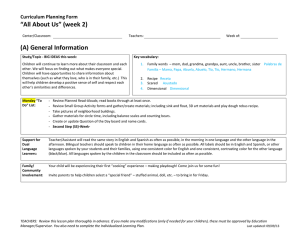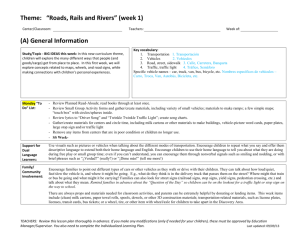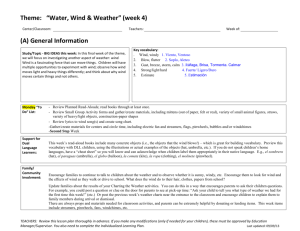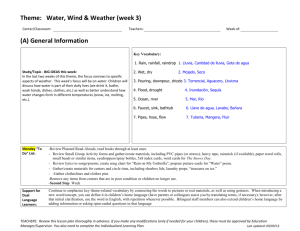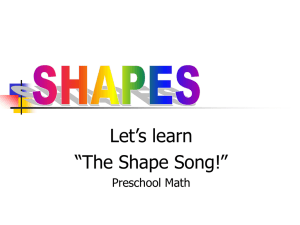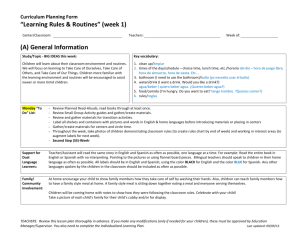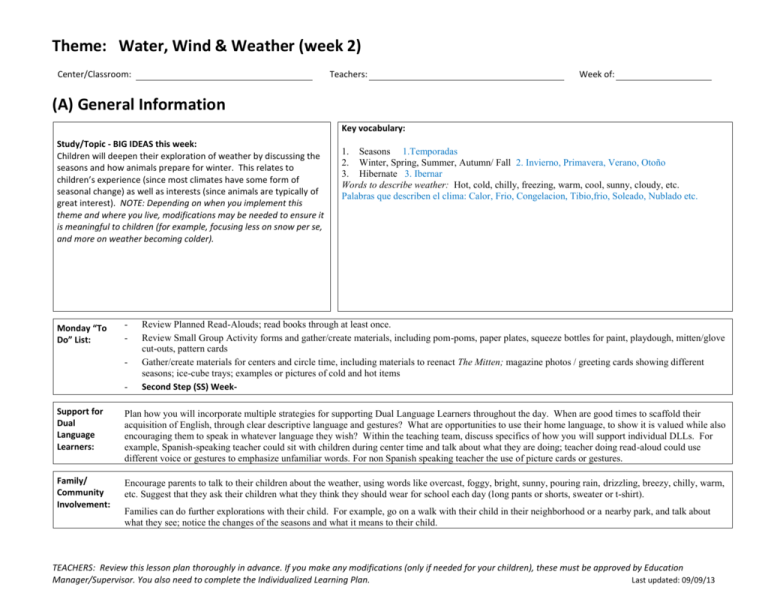
Theme: Water, Wind & Weather (week 2)
Center/Classroom:
Teachers:
Week of:
(A) General Information
Key vocabulary:
Study/Topic - BIG IDEAS this week:
Children will deepen their exploration of weather by discussing the
seasons and how animals prepare for winter. This relates to
children’s experience (since most climates have some form of
seasonal change) as well as interests (since animals are typically of
great interest). NOTE: Depending on when you implement this
theme and where you live, modifications may be needed to ensure it
is meaningful to children (for example, focusing less on snow per se,
and more on weather becoming colder).
Monday “To
Do” List:
-
1. Seasons 1.Temporadas
2. Winter, Spring, Summer, Autumn/ Fall 2. Invierno, Primavera, Verano, Otoño
3. Hibernate 3. Ibernar
Words to describe weather: Hot, cold, chilly, freezing, warm, cool, sunny, cloudy, etc.
Palabras que describen el clima: Calor, Frio, Congelacion, Tibio,frio, Soleado, Nublado etc.
Review Planned Read-Alouds; read books through at least once.
Review Small Group Activity forms and gather/create materials, including pom-poms, paper plates, squeeze bottles for paint, playdough, mitten/glove
cut-outs, pattern cards
Gather/create materials for centers and circle time, including materials to reenact The Mitten; magazine photos / greeting cards showing different
seasons; ice-cube trays; examples or pictures of cold and hot items
Second Step (SS) Week-
Support for
Dual
Language
Learners:
Plan how you will incorporate multiple strategies for supporting Dual Language Learners throughout the day. When are good times to scaffold their
acquisition of English, through clear descriptive language and gestures? What are opportunities to use their home language, to show it is valued while also
encouraging them to speak in whatever language they wish? Within the teaching team, discuss specifics of how you will support individual DLLs. For
example, Spanish-speaking teacher could sit with children during center time and talk about what they are doing; teacher doing read-aloud could use
different voice or gestures to emphasize unfamiliar words. For non Spanish speaking teacher the use of picture cards or gestures.
Family/
Community
Involvement:
Encourage parents to talk to their children about the weather, using words like overcast, foggy, bright, sunny, pouring rain, drizzling, breezy, chilly, warm,
etc. Suggest that they ask their children what they think they should wear for school each day (long pants or shorts, sweater or t-shirt).
Families can do further explorations with their child. For example, go on a walk with their child in their neighborhood or a nearby park, and talk about
what they see; notice the changes of the seasons and what it means to their child.
TEACHERS: Review this lesson plan thoroughly in advance. If you make any modifications (only if needed for your children), these must be approved by Education
Manager/Supervisor. You also need to complete the Individualized Learning Plan.
Last updated: 09/09/13
At the end of the week, post the results of “Charting the Weather” (see circle time) with a caption for parents explaining the activity, and suggesting that
they could continue it at home too.
(B) Materials to Enhance Children’s Play
Blocks
Dramatic Play
Add:
Pictures of familiar buildings or park settings (or other
places) in different seasons.
Toys and Games
Add:
Materials to re-enact The Mitten –animal puppets,
blanket/sheet/sleeping bag
Art
Add:
“How Many Meatballs?” – pompoms, small paper
plates (see small-group activity)
Library/Writing
Add:
Magazine/ greeting card cut outs showing different
seasons
Symmetrical pictures (children’s creations from
previous unit and/or other images you find)
If desired: Food collage materials – pompoms, yarn,
paper plates (see How Many Meatballs small-group
activity)
Add:
Read-aloud books from this week
Sand and Water
Discovery/Science
Keep: Collections of natural objects ( sticks, leaves,
rocks, etc.)
Add:
Magnifying lenses
“Find That Number”: have number cards (1-10, with
numeral and dots) and encourage children to count a
set of natural items that corresponds with a particular
number card.
Music and Movement
Computers
Add:
Snow, finely crushed ice, or water with ice cubes in it.
OR ice cubes in sealed baggies
Or, if weather is cold enough, leave water table outside
overnight to chill or freeze!
Ice-cube trays, other items for pouring, measuring or
“cooking”
Outdoors
Cooking
(C) Group Experiences
Monday
Arrival
Tuesday
Arrival: Attendance graph
Wednesday
Arrival: Attendance graph
Thursday
Arrival: Attendance graph
Friday
Arrival: Attendance graph
© 2012 Acelero, Inc. All Rights Reserved. Uses are subject to the limitations set forth in your user agreement. Your right to use these materials is contingent upon remaining a current
SARGE subscriber with Acelero, Inc.
Monday
Opening
Circle
Movement
Relaxation
Transitions
Closing
Circle
Tuesday
(QOTD): Which do you
like better, wearing short
sleeves or long sleeves?
Provide visuals of each
answer choice. Have
children answer charting
with whiteboard/pocket
chart/etc.
Morning Circle:
Welcome song & one other
Chart Weather
Review daily schedule and
rules now and throughout
the day
Review results of QOTD
with the full group,
counting each column and
writing the numeral.
SS Puppet Script
Wednesday
Thursday
Friday
Morning Circle:
Welcome song & one other
Morning Circle:
Welcome song & one other
Chart Weather
Morning Circle:
Welcome song & one other
Chart Weather ** After
tallying today’s weather,
look back at the week and
make comparisons. E.g.,
how many days was it
sunny this week? Were
there more rainy days or
sunny days? What kind of
weather happened the least?
Etc.
Chart Weather
Review daily schedule and
rules now and throughout
the day
Transition: QOTD: What is
your favorite season?
(Spring/ Fall/ Winter/
Summer) Provide visuals of
each answer choice. Have
children respond so you can
engage in individual
feedback loops; e.g., “why
summer? What do you like
about winter?”
Music/Movement:
“Hibernation Dance” (see
below) & one other
Transition:
Relaxation:
Music/Movement: SS Song
& Mr. Sun
Transition:
Relaxation:
Transition: SS Brain
BuilderClosing Circle:
Goodbye song
Closing Circle:
Revisit QOTD weather,
count, write numeral.
Goodbye song
Cold vs. Hot: Show a
variety of items/pictures
and ask children to identify
which are cold and which
are hot. (E.g. snow vs. sun,
ice cream vs. soup, etc.)
Review daily schedule and
rules now and throughout
the day
Transition: Pull up TS Gold
Activity “Rhyming Riddles”
Music/Movement: SS Song
& “Whistling Wind”
Sung to If you're happy and you
know it"
If you hear the whistling wind,
Cup your ears.
If you hear the whistling wind,
Cup your ears.
If you hear it in the trees
Making music with the leaves,
If you hear the whistling wind,
Cup your ears.
If you feel the Blustery wind,
Whirl around
If you feel the blustery wind,
Whirl around.
If you feel it lift your hair
Like a kite up in the air,
If you feel the blustery wind,
Whirl around.
Review daily schedule and
rules now and throughout
the day
Transition:
SS Skill Activity
Music/Movement: Choose
on other and “Rainy”
Sung to "Frere Jacques"
It is raining, It is raining,
On my head, on my head.
Pitter, patter raindrops,
Pitter, patter raindrops,
I'm all wet, I'm all wet!
Relaxation:
Transition: SS Brain
Builder-Mixed
Closing Circle:
Goodbye song
© 2012 Acelero, Inc. All Rights Reserved. Uses are subject to the limitations set forth in your user agreement. Your right to use these materials is contingent upon remaining a current
SARGE subscriber with Acelero, Inc.
Monday
Tuesday
Wednesday
Thursday
Friday
Relaxation:
Transition:
Group 1: Time to Sleep
ReadAlouds
Group 2: The Mitten by Jan
Brett
(focus on children’s
understanding and
enjoyment
Group 1: Animal Homes;
have children draw and talk
about the animal homes in
the book
SmallGroup
Activity
Group 2: Mitten-Glove
Patterns
Group 1: The Mitten by Jan
Brett
(focus on children’s
understanding and
enjoyment
Group 2: Time to Sleep
Group 1: Mitten-Glove
Patterns
Group 2: Animal Homes;
have children draw and talk
about the animal homes in
the book
Special
Activities
Tangible
Acknowledgement System:
Noticing changes in
weather: Discuss the
clothes children wore to
school and how those relate
to the weather. E.g. is
anyone wearing shorts? Did
anyone wear a jacket to
school? (etc.) If possible,
show photos of children
from earlier in the year
(wearing warm-weather
clothes), as a contrast.
Play music and have
children move/dance like an
animal. When music stops,
children ‘hibernate’ by
lying down on the carpet.
After, ask what animals
they were?
Outside
Inclement Weather Plan:
Point out and discuss with
children any changes in
weather or signs of the
season (snow, wind, plants
Observe any “wild animals”
near your center: squirrels,
chipmunks, birds, etc.
Closing Circle:
Goodbye song
Group 1: SS Story and
Discussion
Group 1: SS Book-
Group 2: SS Book-
Group 2: SS Story and
Discussion-
Group 1: SS Skill Practice
Activity
Group 1: Exploring
Symmetry (continued)
Group 2: Exploring
Symmetry (continued)
Group 2: SS Skill Practice
Activity
How Are These Books the
Same? Lay out books from
this week and/or last week.
Encourage children to think
about their similarities and
to find two books that
“match” in some way. (E.g.,
two books about animals;
two books that have snow
in them…) Point out that
two books can be similar in
one way, but other items are
similar in another way.
© 2012 Acelero, Inc. All Rights Reserved. Uses are subject to the limitations set forth in your user agreement. Your right to use these materials is contingent upon remaining a current
SARGE subscriber with Acelero, Inc.
Monday
Tuesday
Wednesday
growing, leaves, etc). Use
vocabulary like chilly,
breezy, warm, bright, foggy,
etc.
Thursday
Friday
“Gathering Food for
Winter” – hide acorns or
other small items in
advance, then children can
play at being field mice,
gathering the “food” and
storing it in a safe place.
Individual Child Planning Form
School Readiness Goal
Focus Domain(s)
Physical
Approaches to
Learning
Language &
Literacy
Cogn./ Gen.
Knowledge
Name
Soc-Emotional
Focus
Date
Child’s
Week of:
Strategy/Activity
Focus TS
GOLD
Objective(s)
Why Chosen?
(IFSP, TS Gold Report,
family input, conference
goal, etc.)
NOTE: Children with similar needs may benefit from
differentiated instruction (e.g. during small-group activity).
You can use the “Small Group” column at right to make notes
about possible groupings.
Example: 1. Routine – activity, state how you are
individualizing for this child.
CHECK when
implemented
Teachers:
Possible small-group?
Center/Classroom:
1.
Tuesday
2.
3.
1.
Tuesday
2.
3.
1.
2.
3.
© 2012 Acelero, Inc. All Rights Reserved. Uses are subject to the limitations set forth in your user agreement. Your right to use these materials is contingent upon remaining a current
SARGE subscriber with Acelero, Inc.
1.
2.
3.
1.
2.
3.
1.
2.
3.
1.
2.
3.
IFSP Child Planning
Child’s Name
IFSP Goals
Classroom Plan: What’s the Activity/Who’s Supporting the Child
*Please review all IFSP plans including Speech Only to ensure implementation of all classroom goals.
© 2012 Acelero, Inc. All Rights Reserved. Uses are subject to the limitations set forth in your user agreement. Your right to use these materials is contingent upon remaining a current
SARGE subscriber with Acelero, Inc.
*For speech goals the what/who would be: Directed by the Speech Language Therapist
© 2012 Acelero, Inc. All Rights Reserved. Uses are subject to the limitations set forth in your user agreement. Your right to use these materials is contingent upon remaining a current
SARGE subscriber with Acelero, Inc.

